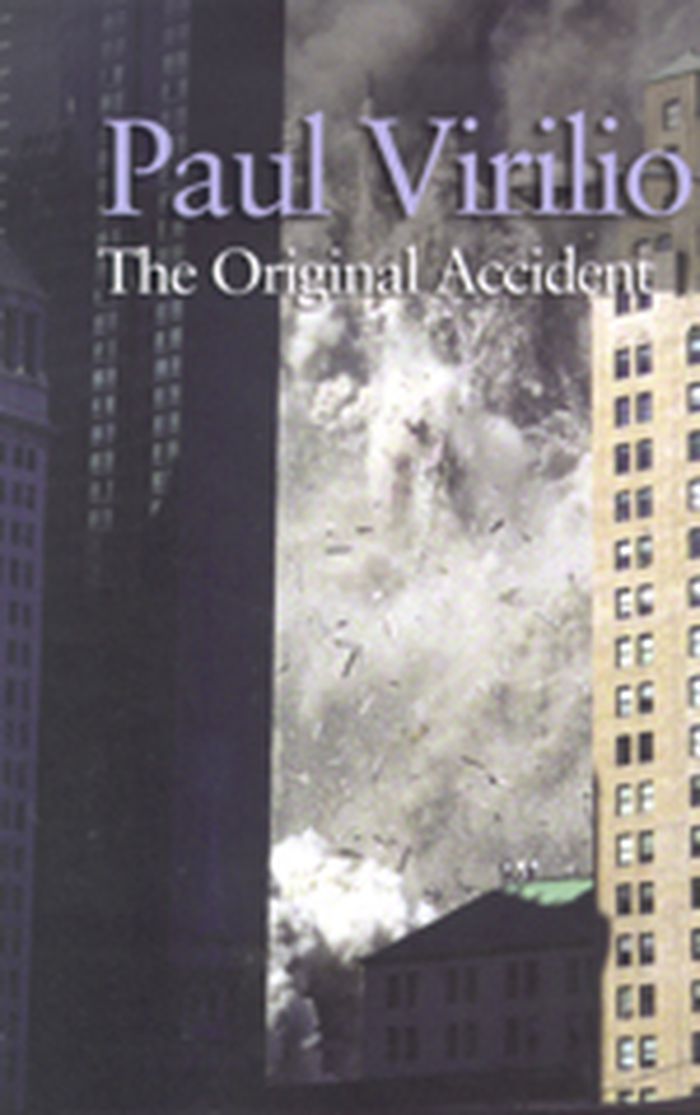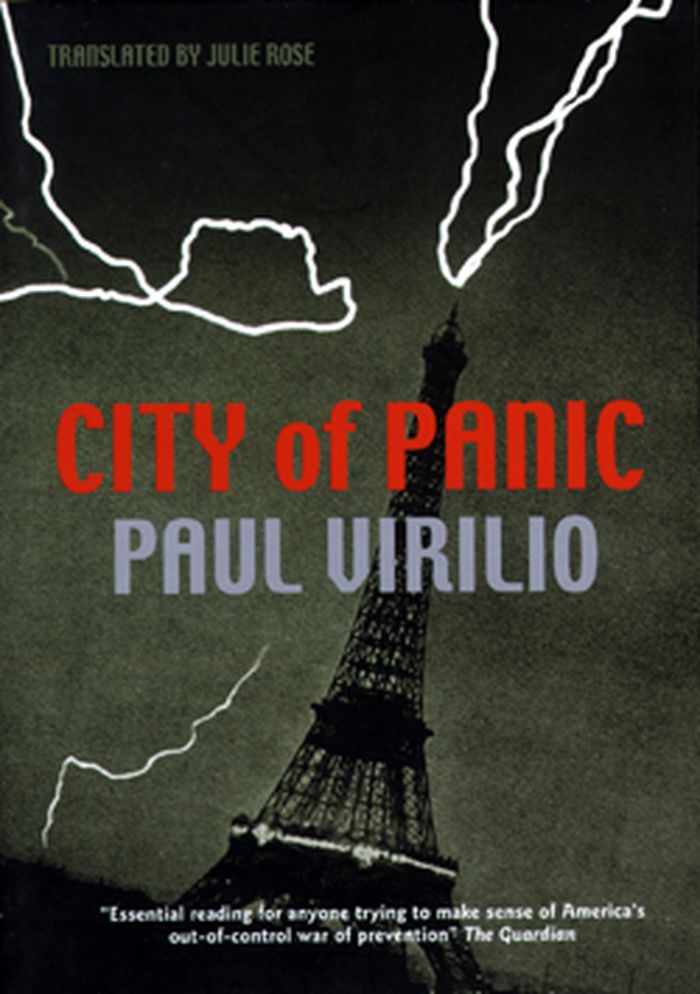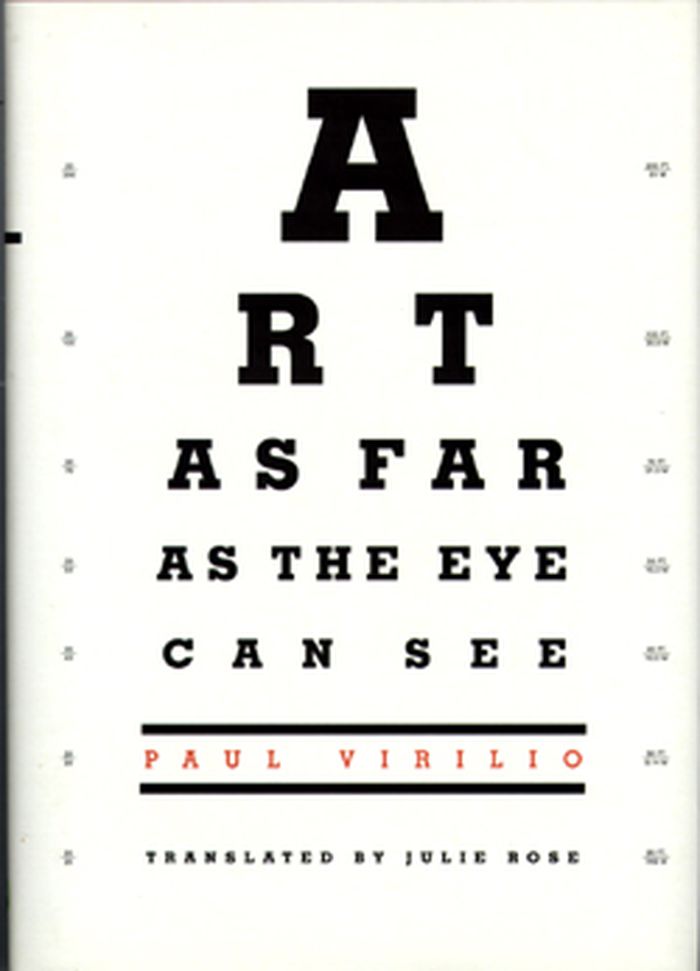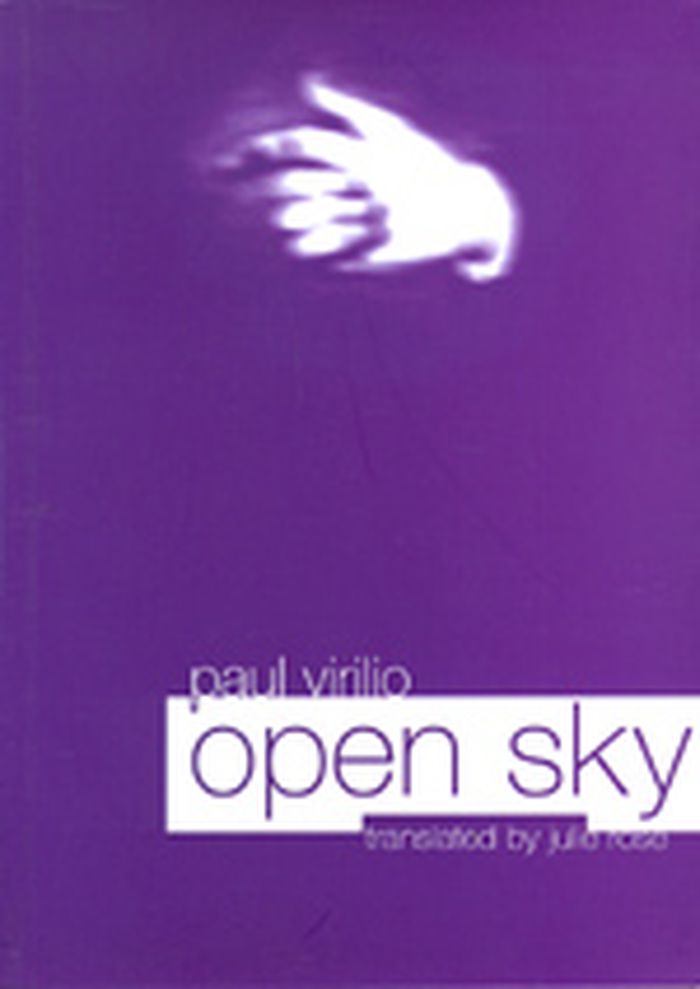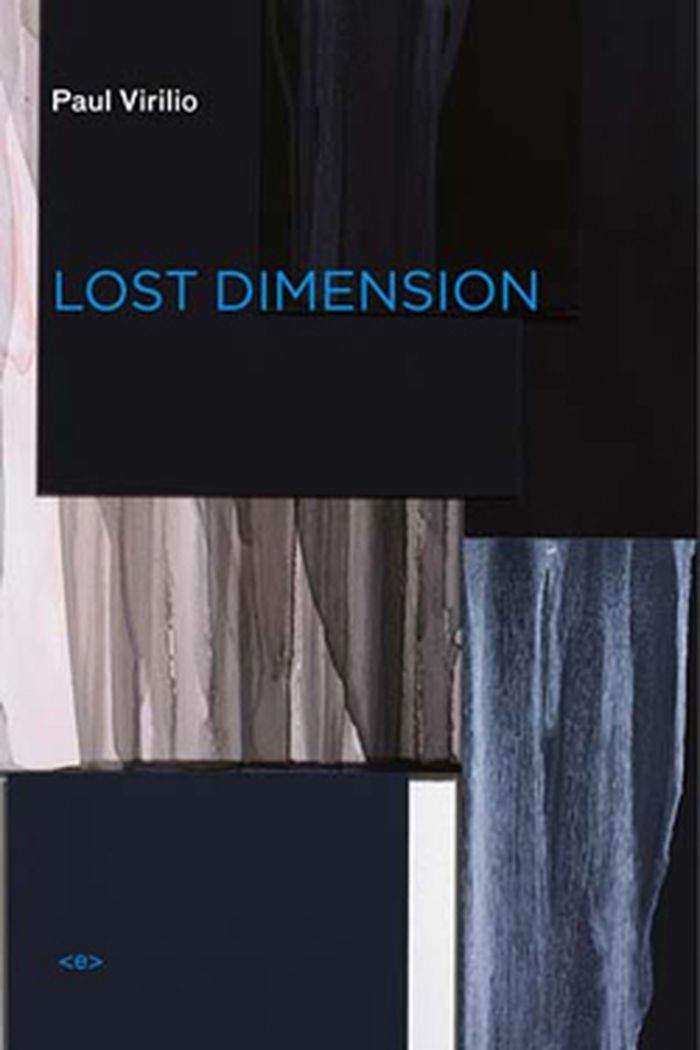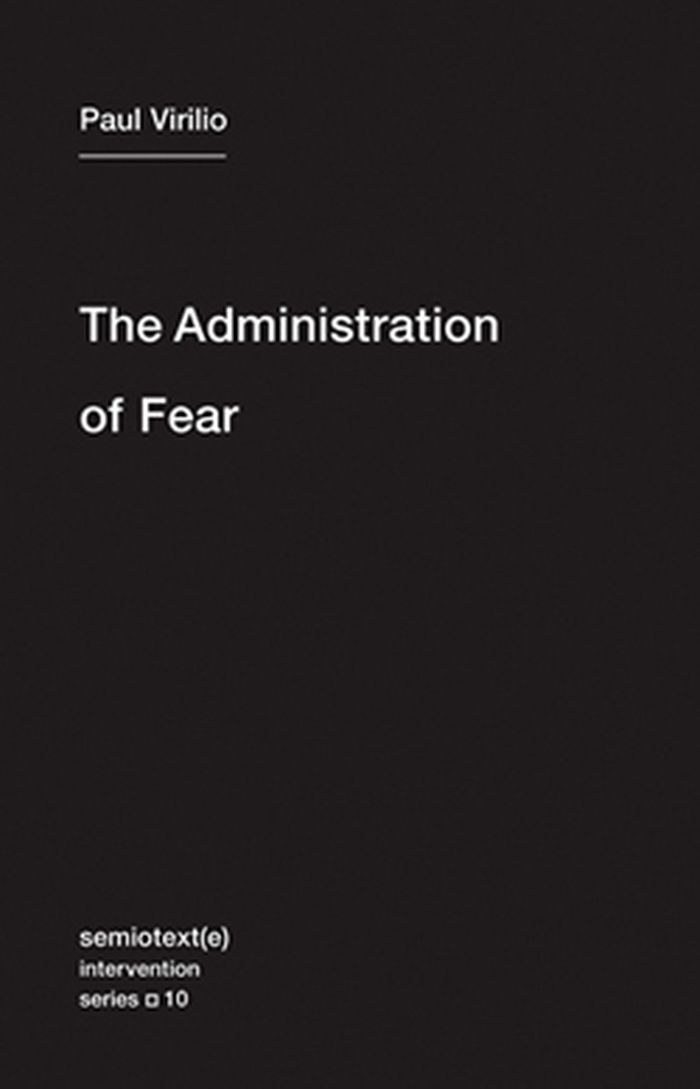The original accident
$21.99
(available to order)
Summary:
Urging us to face up to the consequences of our braves-new-world technologies, Virilio calls for the creation of a Museum of the Accident to fight our habituation to horror and violence, and our daily overexposure to terror, in the name, not of some preventive war, but of a preventive intelligence that would help us deal with both natural and artificial disasters.
The original accident
Actions:
Price:
$21.99
(available to order)
Summary:
Urging us to face up to the consequences of our braves-new-world technologies, Virilio calls for the creation of a Museum of the Accident to fight our habituation to horror and violence, and our daily overexposure to terror, in the name, not of some preventive war, but of a preventive intelligence that would help us deal with both natural and artificial disasters.
Critical Theory
City of Panic
$19.95
(available to order)
Summary:
City of Panic opens with a journey across the airy boulevards of Paris and into the crypt pf its Metro. Along the way, City of Panic tells the story of all cities. Cities everywhere are being reconstructed through a campaign of panic, the proliferation of gated-communities, policed shopping malls, the ever-widening net of surveillance, and a media consistently(...)
City of Panic
Actions:
Price:
$19.95
(available to order)
Summary:
City of Panic opens with a journey across the airy boulevards of Paris and into the crypt pf its Metro. Along the way, City of Panic tells the story of all cities. Cities everywhere are being reconstructed through a campaign of panic, the proliferation of gated-communities, policed shopping malls, the ever-widening net of surveillance, and a media consistently fabricating a world of fear. As the past is torn downand replaced with an identikit present we seem to have accpted that our cities really are war zones and that every city must ben the same.
Architectural Theory
$27.95
(available to order)
Summary:
Art as far as the eye can see puts art back where it matters, at the center of politics. Art used to be an engagement between artist and materials. But, in our new media world, art has changed; its very materials have changed and have become technologized. This change reflects a broader social shift. Speed and politics, what Virilio defined as the key characteristics(...)
Art as far as the eye can see
Actions:
Price:
$27.95
(available to order)
Summary:
Art as far as the eye can see puts art back where it matters, at the center of politics. Art used to be an engagement between artist and materials. But, in our new media world, art has changed; its very materials have changed and have become technologized. This change reflects a broader social shift. Speed and politics, what Virilio defined as the key characteristics of the twentieth century, have been and mass culture. And the defining characteristics of mass culture today is panic.
Critical Theory
$58.00
(available to order)
Summary:
Out of print for almost a decade, this cult book is finally back. In 1994, the first English-language translation of the classic French edition of 1975 - which accompanied an exhibition of Virilio's photographs at the Centre Pompidou -, was published.
April 2006, New York
Paul Virilio: bunker archeology
Actions:
Price:
$58.00
(available to order)
Summary:
Out of print for almost a decade, this cult book is finally back. In 1994, the first English-language translation of the classic French edition of 1975 - which accompanied an exhibition of Virilio's photographs at the Centre Pompidou -, was published.
books
The art of the motor
$22.95
(available to order)
Summary:
This book represents a major new statement of Virilio's highly original philosophy of technology. It includes analysis of such recent developments as nanotechnology and virtual reality. Translated by Julie Rose.
The art of the motor
Actions:
Price:
$22.95
(available to order)
Summary:
This book represents a major new statement of Virilio's highly original philosophy of technology. It includes analysis of such recent developments as nanotechnology and virtual reality. Translated by Julie Rose.
books
October 1995, Minneapolis
Architectural Theory
$22.00
(available to order)
Summary:
Deepening and extending his earlier work, Paul Virilio explores the growing danger of what he calls a "generalized accident," provoked by the breakdown of our collective and individual relation to time, space and movement in the contex of global electronic media. Translated by Julie Rose.
Open sky
Actions:
Price:
$22.00
(available to order)
Summary:
Deepening and extending his earlier work, Paul Virilio explores the growing danger of what he calls a "generalized accident," provoked by the breakdown of our collective and individual relation to time, space and movement in the contex of global electronic media. Translated by Julie Rose.
Critical Theory
books
$47.95
(available to order)
Summary:
À l'occasion de son trentième, le manifeste Architecture Principe réédite l'intégrale des neuf numéros parus en 1966 et lance son dixième et tout dernier numéro, sous le titre ''Désorientation ou Dislocation''. Avec des essais de CoopHimmelb(l)au, Daniel Libeskind, Jean Nouvel, François Seigneur, Bernard Tschumi et Frédéric Migayrou.
Architectural Theory
October 1996, Besançon
Architecture principe 1966 et 1996
Actions:
Price:
$47.95
(available to order)
Summary:
À l'occasion de son trentième, le manifeste Architecture Principe réédite l'intégrale des neuf numéros parus en 1966 et lance son dixième et tout dernier numéro, sous le titre ''Désorientation ou Dislocation''. Avec des essais de CoopHimmelb(l)au, Daniel Libeskind, Jean Nouvel, François Seigneur, Bernard Tschumi et Frédéric Migayrou.
books
October 1996, Besançon
Architectural Theory
books
The information bomb
$33.00
(available to order)
Summary:
"Civilization or the militarization of science?" With this typically hyperbolic and provocative question as a starting point, Paul Virilio explores the dominion of techno-science, cyberwar and the new information technologies over our lives . . . and deaths. After the era of the atomic bomb, Virilio(...)
The information bomb
Actions:
Price:
$33.00
(available to order)
Summary:
"Civilization or the militarization of science?" With this typically hyperbolic and provocative question as a starting point, Paul Virilio explores the dominion of techno-science, cyberwar and the new information technologies over our lives . . . and deaths. After the era of the atomic bomb, Virilio posits an era of genetic and information bombs which replace the apocalyptic bang of nuclear death with the whimper of a subliminally reinforced eugenics. We are entering the age of euthanasia. These exhilarating bulletins from the information war extend the range of Virilio's work. "The Information Bomb" spans everything from Fukuyama to Larry Flynt, the Sensation exhibition of New British Art to space travel, all seen through the optic of Virilio's trenchant and committed theoretical position.
books
January 1900, London
Architectural Theory
Lost dimension
$17.95
(available to order)
Summary:
To read these five essays of 1983 is to begin to come to terms with the theoretical cataclysm of the present. In Lost Dimension, Paul Virilio considers the displacement of the concept of dimensional space by Einsteinian space/time as it is related to the transparent boundaries of the postmodern city and contemporary economy. Virilio imagines a coming world of interactive,(...)
Lost dimension
Actions:
Price:
$17.95
(available to order)
Summary:
To read these five essays of 1983 is to begin to come to terms with the theoretical cataclysm of the present. In Lost Dimension, Paul Virilio considers the displacement of the concept of dimensional space by Einsteinian space/time as it is related to the transparent boundaries of the postmodern city and contemporary economy. Virilio imagines a coming world of interactive, informational networks offering a prison-house of illusionary transcendence. He pictures global terrorism (perpetrated by and against technological states) filling up the surreal void of an abandoned real. In a multidisciplinary excavation of contemporary physics, architecture, esthetic theory, and sociology, Virilio traces the dystopic unity of the contemporary Western predicament with lightning prescience and clarity.
Critical Theory
$18.95
(available in store)
Summary:
We are living under the administration of fear: fear has become an environment, an everyday landscape. There was a time when wars, famines, and epidemics were localized and limited by a certain time frame. Today, it is the world itself that is limited, saturated, and manipulated, the world itself that seizes us and confines us with a stressful claustrophobia. Stock-market(...)
Paul Virilio : the administration of fear
Actions:
Price:
$18.95
(available in store)
Summary:
We are living under the administration of fear: fear has become an environment, an everyday landscape. There was a time when wars, famines, and epidemics were localized and limited by a certain time frame. Today, it is the world itself that is limited, saturated, and manipulated, the world itself that seizes us and confines us with a stressful claustrophobia. Stock-market crises, undifferentiated terrorism, lightning pandemics, "professional" suicides.... Fear has become the world we live in.
Critical Theory
